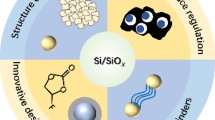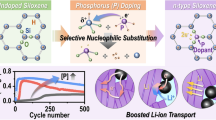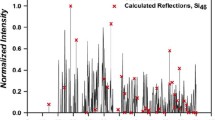Highlights
-
By selecting 4-methylbiphenyl as an anion ligand and 2-methyltetrahydrofuran as a solvent, the as-prepared micro-sized SiO/C anode can achieve an initial Coulombic efficiency of ~100%.
-
Molecular dynamics simulations demonstrate that the ideal prelithiation efficiency can be achieved by choosing appropriate anion ligand and solvent to regulate the solvation structure of Li+.
-
The positive effect of pre-lithiation on cycle performance has been verified by using an in-situ electrochemical dilatometry and solid electrolyte interphase film.
Abstract
The solvation structure of Li+ in chemical prelithiation reagent plays a key role in improving the low initial Coulombic efficiency (ICE) and poor cycle performance of silicon-based materials. Nevertheless, the chemical prelithiation agent is difficult to dope active Li+ in silicon-based anodes because of their low working voltage and sluggish Li+ diffusion rate. By selecting the lithium–arene complex reagent with 4-methylbiphenyl as an anion ligand and 2-methyltetrahydrofuran as a solvent, the as-prepared micro-sized SiO/C anode can achieve an ICE of nearly 100%. Interestingly, the best prelithium efficiency does not correspond to the lowest redox half-potential (E1/2), and the prelithiation efficiency is determined by the specific influencing factors (E1/2, Li+ concentration, desolvation energy, and ion diffusion path). In addition, molecular dynamics simulations demonstrate that the ideal prelithiation efficiency can be achieved by choosing appropriate anion ligand and solvent to regulate the solvation structure of Li+. Furthermore, the positive effect of prelithiation on cycle performance has been verified by using an in-situ electrochemical dilatometry and solid electrolyte interphase film characterizations.

Similar content being viewed by others
Avoid common mistakes on your manuscript.
1 Introduction
For realizing lithium-ion batteries (LIBs) with higher energy density, the silicon-based anode becomes a promising candidate in the market by virtue of its high theoretical specific capacity, low working voltage, and cost advantages [1,2,3]. However, the significant volume expansion of silicon-based material will destroy a three-dimensional (3D) conductive network of the electrode, resulting in the exfoliation of the active material from the current collector [4,5,6]. The formation of solid electrolyte interphase (SEI) film and the irreversible components will consume a large amount of active Li+ and suffer from a low initial Coulombic efficiency (ICE) [7,8,9,10]. Especially in the full battery, the limited Li+ will further deteriorate its electrochemical performance, which reduces energy density and cycle life. Besides, its low intrinsic electron conductivity (< 10−5 S cm−1) and sluggish Li+ diffusion rate (< 10−14 cm2 s−1) also lead to poor reaction kinetics [11,12,13].
Currently, sustained research efforts have been dedicated to optimizing and heightening its electrochemical property. Considering the production costs, complex synthetic procedures, and actual application scenarios, the designs of multi-level conductivity carbon skeletons for silicon-based materials would be an effective way to realize industrialization [5, 14,15,16,17,18]. However, a routine amorphous coating layer has a lower conductivity than crystalline carbon. At the same time, the amorphous carbon skeleton with plentiful defect sites will trap Li+ from participating in the subsequent cycles [19, 20]. In addition, the reserved buffer space significantly increases the specific surface area of the electrode, which would further consume a lot of electrolytes, resulting in a low ICE [19, 21,Full size image
However, when 4BP was used as anion ligand, there are still doubts. Compared with THF as a solvent, LAC reagent with 2-MTHF as a solvent exhibits a lower Li+ concentration, but the ICE of the SiO/C anode is significantly enhanced. Therefore, the desolvation kinetics of Li+ in LAC reagent was discussed [10, 41]. The SiO/C particles were surrounded by Li+-solvent. With the removal of solvent and anion ligands, Li+ was embedded into SiO/C particles to achieve prelithiation (Fig. S3). Based on the ab initio molecular dynamics simulations, the solvation structures of Li+ in LACs were optimized to obtain their first solvation sheath structure. The initial structures of LACs were set up by randomly placing anion/solvent molecules based on their molar ratios. The radial distribution functions (RDFs) of LACs usually refer to the distribution probability of other granules in space given the coordinates of a granule. In Fig. 3d–f, it should be noted that the aromatic-C, bridge-C, and sp3-C are used to locate the position of BP or 4BP, and O is used to locate the position of THF or 2-MTHF. Combined with the corresponding integrals in Fig. S4, each Li+ is coordinated with two benzene rings on average, and BP + THF system is slightly larger than 4BP + THF system. Coordinated with one O atom, 4BP + THF system is slightly larger than BP + THF system. However, each Li+ in 4BP + 2-MTHF system is coordinated with about two benzene ring planes on average, and the O atom is almost not involved in the coordination. According to the above results, the first solvation sheath structures with electrostatic potential map**s of the three systems are shown in Fig. 3g. Based on quantum chemical calculations, the 4BP + 2-MTHF system exhibits the lowest desolvation energies of Li+ (604.58 kJ mol−1). By comparison, the desolvation energies of Li+ in other two systems are 649.24 kJ mol−1 and 655.97 kJ mol−1, respectively. And compared to the other two systems, the 4BP + 2-MTHF system displays a more uniform electrostatic potential field. The optimized electron density distribution is favor to reduce the binding force of Li+ and anionic ligands, which reduce E1/2 values [39]. Therefore, the ideal prelithiation efficiency can be achieved by choosing appropriate anion ligands and solvents to regulate the solvation structure, which can balance the relationship among E1/2, Li+ concentration and desolvation energy.
Except for the prelithiation ability of LAC reagent, different silicon-based materials were tried to verify the roles of the ion diffusion path inside active materials in the prelithiation efficiency. The morphologies of micron-sized SiO, nSiO, and nSi particles were observed by SEM test. In Fig. 4a, commercial SiO particles show a non-uniform size, and their distribution varies from a dozen microns to dozens of microns. To compare the effect of particle sizes on the degree of prelithiation, micron-sized SiO was broken into nSiO particles by high-energy ball milling (HEBM, Fig. 4b). Figure 4c shows nSi particles with the same nanoscale. Subsequently, SiO, nSiO, and nSi anodes were also immersed in LAC (4BP + 2-MTHF) reagent for 10 min. Figure 4d displays that the ICEs of SiO and p-SiO anodes are 66.6% and 91.5%, respectively. With the size of commercial SiO particle reaching nanometer level, the prelithiation efficiency of nSiO is greatly improved (Fig. 4e), and the ICE is increased from 67.7% (nSiO) to 117.8% (p-nSiO). After nanorization, the ICE of nSiO increases to 40.1%, which is much higher than that of SiO (24.9%). By contrast, the ICE of prelithiated nSi anode material is as high as 123.0%, and the corresponding ICE increase is 39.3% (Fig. 4f). According to the above results, we have assumed that the prelithiation efficiency of electrode materials is also governed by the Li+ diffusion path (Fig. 4g). With the decrease in particle size, it takes less time for Li+ to diffuse from the particle surface to the material interior [48, 49]. Meanwhile, a larger contact area with the prelithiation solvent is also conducive to improving the prelithiation efficiency. And the dense carbon layer coated on the surface of SiO particles will hinder the rapid embedding of Li+, thereby weakening the prelithiation efficiency. If we can combine the modification process with the prelithiation technology, the prelithiation time of silicon-based anodes will be shortened to reduce costs.
SEM images of a SiO, b nSiO, and c nSi particles. Initial discharge–charge profiles of d SiO and p-SiO anodes, e nSiO and p-nSiO anodes, and f nSi and p-Si anodes. g Influencing factors of prelithiation efficiency of SiO/C, SiO, nSiO, and nSi anodes. h Initial charge–discharge profiles and i cycle performances of SiO/C@LCO and p-SiO/C@LCO full cells
To prove the significance of prelithiation in the realization of high-energy density, we have assembled full cells by using the SiO/C and p-SiO/C as anodes and the commercial LiCoO2 (LCO) as a cathode. In Fig. S5a, the initial charge–discharge capacities of LCO cathode were 178.3 and 167.1 mAh g−1, respectively. After 35 cycles, the reversible specific capacity of the LCO cathode decreased slightly, which was stable at 171.8 mAh g−1 (Fig. S5b). After capacity and voltage matching, the voltage range of the full cells is 3–4.35 V. The full cells were first activated at 10 mA g−1. As is shown in Fig. 4h, the p-SiO/C@LCO full cell exhibits initial charge–discharge capacities of 179.8 and 150.4 mAh g−1, corresponding to a high ICE of 83.7%. Due to the large amount of active Li+ loss caused by the initial irreversible process, the ICE of SiO/C@LCO full cell is only 40.9%. After 35 cycles in Fig. 4i, the reversible capacity of p-SiO/C@LCO full cell (125.4 mAh g−1) is much higher than that of SiO/C@LCO (53.7 mAh g−1).
3.3 Effect of Prelithiation on Cycle Stability
Considering the good stability of the LCO cathode, the difference in capacity retention of full cell is attributed to the prelithiation of SiO/C particles. Figure 5a shows the cycle performances of SiO/C and p-SiO/C anodes at 0.2 A g−1. After 100 cycles, the reversible capacity of p-SiO/C anode is 813.9 mAh g−1 and the corresponding capacity retention is 64.6%, whereas the capacity retention of SiO/C anode is only 7.9%. The in-situ electrochemical dilatometer was used to monitor the thickness changes of SiO/C and p-SiO/C anodes during cycling (Fig. 5b) [50, 51]. The voltage-thickness curves of SiO/C and p-SiO/C anodes were shown in Fig. 5c, d. During the first cycle, the thickness variation of SiO/C anode is 70.8%, which is higher than that of p-SiO/C anode (61.5%). These results demonstrate that the p-SiO/C anode successfully realizes Li+ pre-embedding, so the first thickness change decreases. In addition, during the first two cycles, p-SiO/C anode shows highly reversible thickness variations, which are 52.9% and 41.2%, respectively. By comparison, the reversible thickness variations of SiO/C anode were only 49.9% and 28.7%. The main reason is that the prelithiation of SiO/C anode can prevent effectively mechanical degradation caused by repeated volume changes. At the same time, the pre-generation of SEI film can also reduce the loss of Li+ by the irreversible reaction. In order to verify our view, we conducted SEM tests on SiO/C and p-SiO/C anodes. In Fig. 5e, different shapes of SiO/C particles are still angular with abundant pore structures on the electrode surface. After prelithiation, the edges of SiO/C particles disappear owing to pre-expansion, and the surface of particles becomes smooth. Besides, the pore structure on the surface of p-SiO/C electrode decreased (Fig. 5f). These phenomena further confirm the positive effect of prelithiation on the improvement of cycle stability.
In addition. the SEI film on electrode surface plays an important role in the optimization of electrochemical performance. In general, the prelithiated electrode needs to be in contact with commercial electrolyte to form a SEI film in advance, so as to reduce the active Li+ loss in full cells (Fig. 6a). Nevertheless, the cycle performance of p-SiO/C anode is still not ideal. Therefore, ex-situ characterizations were carried out to reveal the failure mechanism of p-SiO/C anodes before and after cycling. Firstly, the morphologies and structures of p-SiO/C anodes were characterized by SEM tests. In Fig. 6b, the surface of p-SiO/C electrode is smooth and flat before cycling, and the surface morphology of p-SiO/C material can be seen probably. This is due to the formation of a thin SEI film on the surface of the prelithiated electrode after contacting with the electrolyte. After multiple cycles (Fig. 6c), the repeated volume expansion of p-SiO/C particles results in particle displacement and SEI fragmentation. Therefore, the surface of p-SiO/C electrode becomes uneven, indicating there is a thick SEI film. TEM tests were also further used to reveal the SEI film on the surface of p-SiO/C particles. Before and after cycles, p-SiO/C particles still maintained the integrity of the structure (Fig. S7a, b). Figure S7c shows that p-SiO/C particles were covered by a thin amorphous SEI film before cycling. And after multiple cycles, the SEI film became thicker and uneven (Fig. S7d). The corresponding STEM image and elemental map**s of p-SiO/C anodes after cycles were illustrated in Fig. S8, where the uneven distribution of fluorine further confirms the unevenness of the SEI film. The above phenomenon is consistent with SEM results.
Subsequently, the SEI components of p-SiO/C anodes before and after cycling were analyzed. XPS test was also used to further reveal the composition difference between the SEI film formed by prelithiation and the SEI film formed after crushing. Figure 6d-f are the C 1s, Li 1s, and F 1s spectra of p-SiO/C anodes before and after cycling [10, 52,53,54]. Compared with that of p-SiO/C anode before cycling, the peak intensities of ROCO2Li and Li2CO3 after cycling were significantly enhanced, indicating that a large number of EC and DEC decomposed during cycling and participated in the formation of SEI film (Fig. 6d). The above results are further verified in Li 1s spectrum (Fig. 6e). LiF mainly comes from the decomposition of FEC and LiPF6, and LixPOyFz mainly comes from the decomposition of LiPF6 [55]. Herein, the high electrical insulation and high mechanical strength of LiF can avoid electrolyte decomposition and adapt to repeated volume changes of Si anodes. At the same time, the formation of nanoscale heterojunctions among LiF and other inorganic components can meet the needs of SEI film for ionic conductivity, even though LiF is an ionic insulator. Therefore, the improved SEI film exhibits good cycle stability and fast ion permeability [10, 56]. In Fig. 6e, f, the LixPOyFz peak area of p-SiO/C anode before cycling accounts for more than that of p-SiO/C anode after cycling, while the LiF peak area accounted for less. The above results indicate that it is difficult for the SEI film generated in the prelithiation process to obtain sufficient mechanical toughness to improve the volume expansion of the silicon-based anode. Therefore, the reasonable construction of SEI component in the prelithiation process is also very important for the optimization of cycle performance.







